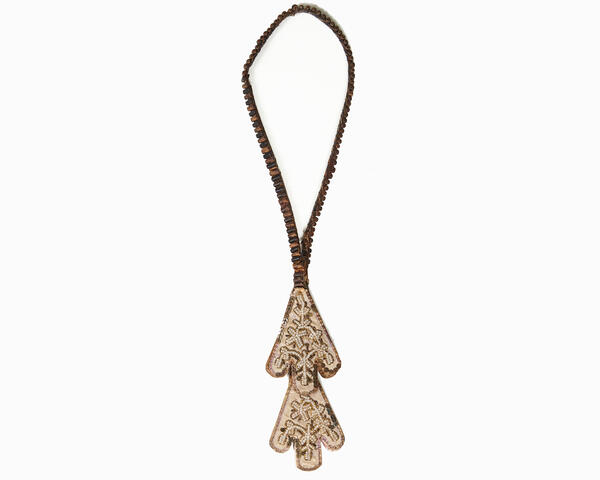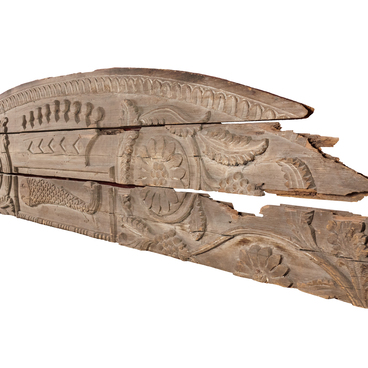The museum collection houses a lestovka of the 19th century. This is a type of rosary that existed in Old Rus' and was preserved among the Old Believers. The word ‘lestovka’ means ‘ladder’. It is a symbol of spiritual ascent. It recalls the biblical story about the dream of Jacob, the son of Isaac. He saw a ladder in his dream. This ladder was set up on earth and reached the heaven. The work of the Christian theologian John of the Ladder is another source of the word’s origin. His work, called ‘The Ladder’, consisted of thirty virtue ‘steps’ every Christian should ascend to reach spiritual perfection.
Lestovka is woven or sewn from two strips — they form a ‘path’ or a ‘strap’. Usually, it was made of thin leather. There was a tradition to put wooden sticks or rolled paper with a written short version of Jesus' prayer in the stitches: ‘Lord Jesus Christ, Son of God, have mercy on me, the sinner’ or ‘God, bless my soul’. The stitches, done this way, served as a symbol of ladder steps.
The four triangles at the lestovka’s end are called ‘lapostki’. Their front side may have beautiful decorations. As a rule, lestovkas for men were dark-colored with the initial letters of the names of the evangelists. Lestovkas for women were in bright or delicate colors and decorated with beads.
For a long time, Russian craftswomen made lestovkas completely from colored beads. For example, for a wedding ceremony, they created a pair of white lestovkas embroidered with beads.
The more familiar rosary beads, unlike the lestovka, were intended only for counting prayers and had no symbolic meaning. In lestovka, every detail had a deep spiritual meaning.
According to the number of steps, a lestovka is divided into four segments. They are separated from each other by three ‘great’ steps. The lestovka begins with three small steps. Then there is a gap of smooth surface — it symbolizes the Earth. There are twelve steps from it to the first ‘great’ step. They represent the twelve apostles. There are thirty-eight steps to the second ‘great’ step. This number is a symbol of the forty-day fasting period of Christ, as well as the number of weeks that the Virgin carried Him in the womb. Then thirty-three steps follow. They symbolize thirty-three years of the earthly life of Christ. After that there are seventeen steps, they symbolize 17 prophets of the Old Testament. Then there is another smooth segment indicating Heaven. The three steps at the beginning and the end and the three ‘great’ steps in the middle stand for the nine ranks of the angels.
It was customary to hold the lestovka in the left hand, going through its steps — from earth to heaven. The fingers had to be folded in the same way as for the sign of the cross.
Lestovka is woven or sewn from two strips — they form a ‘path’ or a ‘strap’. Usually, it was made of thin leather. There was a tradition to put wooden sticks or rolled paper with a written short version of Jesus' prayer in the stitches: ‘Lord Jesus Christ, Son of God, have mercy on me, the sinner’ or ‘God, bless my soul’. The stitches, done this way, served as a symbol of ladder steps.
The four triangles at the lestovka’s end are called ‘lapostki’. Their front side may have beautiful decorations. As a rule, lestovkas for men were dark-colored with the initial letters of the names of the evangelists. Lestovkas for women were in bright or delicate colors and decorated with beads.
For a long time, Russian craftswomen made lestovkas completely from colored beads. For example, for a wedding ceremony, they created a pair of white lestovkas embroidered with beads.
The more familiar rosary beads, unlike the lestovka, were intended only for counting prayers and had no symbolic meaning. In lestovka, every detail had a deep spiritual meaning.
According to the number of steps, a lestovka is divided into four segments. They are separated from each other by three ‘great’ steps. The lestovka begins with three small steps. Then there is a gap of smooth surface — it symbolizes the Earth. There are twelve steps from it to the first ‘great’ step. They represent the twelve apostles. There are thirty-eight steps to the second ‘great’ step. This number is a symbol of the forty-day fasting period of Christ, as well as the number of weeks that the Virgin carried Him in the womb. Then thirty-three steps follow. They symbolize thirty-three years of the earthly life of Christ. After that there are seventeen steps, they symbolize 17 prophets of the Old Testament. Then there is another smooth segment indicating Heaven. The three steps at the beginning and the end and the three ‘great’ steps in the middle stand for the nine ranks of the angels.
It was customary to hold the lestovka in the left hand, going through its steps — from earth to heaven. The fingers had to be folded in the same way as for the sign of the cross.



